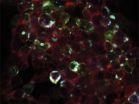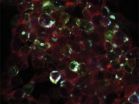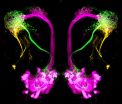(Press-News.org) It's the most basic of ways to find out what something does, whether it's an unmarked circuit breaker or an unidentified gene -- flip its switch and see what happens. New remote-control technology may offer biologists a powerful way to do this with cells and genes.
A team at Rockefeller University and Rensselaer Polytechnic Institute is developing a system that would make it possible to remotely control biological targets in living animals -- rapidly, without wires, implants or drugs.
Today (December 15) in the journal Nature Medicine, the team describes successfully using electromagnetic waves to turn on insulin production to lower blood sugar in diabetic mice. Their system couples a natural iron storage particle, ferritin, to a heat activated ion channel called TRPV1 such that when the metal particle is exposed to a radio wave or magnetic field it opens the channel, leading to the activation of an insulin producing gene. Together, the two proteins act as a nano-machine that can be used to trigger gene expression in cells.
"The method allows one to wirelessly control the expression of genes in a living animal and could potentially be used for conditions like hemophilia to control the production of a missing protein. Two key attributes are that the system is genetically encoded and can activate cells remotely and quickly," says Jeffrey Friedman, Marilyn M. Simpson Professor head of the Laboratory of Molecular Genetics at Rockefeller. "We are now exploring whether the method can also be used to control neural activity as a means for noninvasively modulating the activity of neural circuits." Friedman and his Rensselaer colleague Jonathan S. Dordick were co-senior researchers on the project.
Other techniques exist for remotely controlling the activity of cells or the expression of genes in living animals. But these have limitations. Systems that use light as an on/off signal require permanent implants or are only effective close to the skin, and those that rely on drugs can be slow to switch on and off.
The new system, dubbed radiogenetics, uses a signal, in this case low-frequency radio waves or a magnetic field, to heat or move ferritin particles. They, in turn, prompt the opening of TRPV1, which is situated in the membrane surrounding the cell. Calcium ions then travel through the channel, switching on a synthetic piece of DNA the scientists developed to turn on the production of a downstream gene, which in this study was the insulin gene.
In an earlier study, the researchers used only radio waves as the 'on' signal, but in the current study, they also tested out a related signal - a magnetic field - could also activate insulin production. They found it had a similar effect as the radio waves.
"The use of a radiofrequency-driven magnetic field is a big advance in remote gene expression because it is non-invasive and easily adaptable," says Dordick, who is Howard P. Isermann Professor of Chemical and Biological Engineering and vice president of research at Rensselaer. "You don't have to insert anything -- no wires, no light systems -- the genes are introduced through gene therapy. You could have a wearable device that provides a magnetic field to certain parts of the body and it might be used therapeutically for many diseases, including neurodegenerative diseases. It's limitless at this point."
The choice to look at insulin production was driven by the equipment they used to generate the radio waves and magnetic fields. Because the coil that generates these signals is currently small i.e; only three centimeters in diameter, it was necessary to anesthetize the mice to keep them still. Since anesthesia can repress the production of insulin, the hormone that reduces blood sugar, Stanley and her colleagues designed the genetically encoded system to replace the insulin that is normally reduced by anesthesia in mice.
"Ferritin, a protein-coated iron storage molecule, is normally found throughout the mouse and human body, but in our experiments, we modified it, placing the ferritin particles in different positions to see if we could improve our results," says co-first author Sarah Stanley, a senior research associate in Friedman's lab. "We found tethering the ferritin to the channel to be most effective."
The team's positive results suggest other applications for the system. In late September, Stanley received a first-round BRAIN grant from the ambitious federal initiative seeking to create a dynamic map of the brain in action. Stanley and colleagues plan to adapt this system to switch neurons on and off, and so examine their roles within the brain.
"In this current study, we've shown that by opening the TRPV1 channel to allow calcium ions to enter the cell, we can turn on a gene. Since neurons can be depolarized by calcium and other positively charged ions, such as those the TRPV1 channel controls, we hope that this system may be effective at regulating neural activity."
INFORMATION:
BOSTON (Dec. 16, 2014) -- Extra vitamin E protected older mice from a bacterial infection that commonly causes pneumonia. Microbiologists and nutrition researchers from Tufts University report that the extra vitamin E helped regulate the mice's immune system. The findings, published online in advance of print in the The Journal of Immunology, show promise for studies investigating the effects of vitamin E and infection in humans.
Older adults over age 65 are at high risk for developing pneumonia, an inflammation of the lungs typically caused by infection. The most common ...
A scientific team at UBC and Providence Health Care have genetically engineered mice with less wrinkled skin, despite repeated exposure to wrinkle-inducing ultraviolet (UV) light.
The youthful-looking mice were bred without the gene that produces Granzyme B, an enzyme that immune cells use to destroy harmful pathogens. The UBC-Providence team, led by Professor David Granville and postdoctoral fellow Leigh Parkinson, found that Granzyme B also does harm: When produced and released by skin cells in response to UV light, it triggers the breakdown of collagen, a structural ...
ANN ARBOR--A set of eight hurricane-forecast satellites being developed at the University of Michigan is expected to give deep insights into how and where storms suddenly intensify--a little-understood process that's becoming more crucial to figure out as the climate changes, U-M researchers say.
The Cyclone Global Navigation Satellite System is scheduled to launch in fall 2016. At the American Geophysical Union Meeting in San Francisco this week, U-M researchers released estimates of how significantly CYGNSS could improve wind speed and storm intensity forecasts.
CYGNSS--said ...
Contrary to popular belief, new research suggests that some employees adapt well to pressures caused by changes in the workplace.
Pay cuts, reduced working hours, fewer training and promotion opportunities are just a few of the measures organisations employ to combat economic downturn and industry competition. Where previous research has suggested cut backs result in a demotivated and unhappy workforce, experts from Monash University and The University of Iowa say this might not necessarily be the case.
A new study published in the Journal of Occupational and Organizational ...
A global fleet of composite planes could reduce carbon emissions by up to 15 percent, but the lighter planes alone will not enable the aviation industry to meet its emissions targets, according to new research.
The study, by the Universities of Sheffield, Cambridge and UCL (University College London), is the first to carry out a comprehensive life cycle assessment (LCA) of a composite plane, such as the Boeing Dreamliner 787 or Airbus 350, and extrapolate the results to the global fleet.
The LCA covers manufacture, use and disposal, using publicly available information ...
A team of Chinese and Italian scientists has joined efforts to provide a key to the understudied phaleratus group of blister beetles. During their research the scientists have also discovered a new species from the genus Hycleus, which they named after Marco Polo, as a tribute to their collaboration during the Ph.D. studies. The study was published in the open access journal ZooKeys.
The phaleratus group to which the new species Hycleus marcipoli belongs, is part of the Meloidae family commonly known as the blister beetle family. The representatives of this group get ...
This news release is available in German. Whether an odor is pleasant or disgusting to an organism is not just a matter of taste. Often, an organism's survival depends on its ability to make just such a discrimination, because odors can provide important information about food sources, oviposition sites or suitable mates. However, odor sources can also be signs of lethal hazards. Scientists from the BMBF Research Group Olfactory Coding at the Max Planck Institute for Chemical Ecology in Jena, Germany, have now found that in fruit flies, the quality and intensity of ...
Researchers studied 414 people with severe dementia along with their carers in England, Estonia, Finland, France, Germany, the Netherlands, Spain and Sweden. The study gathered information on quality of life, activities of daily living such as bathing, feeding and dressing and presence of depressive symptoms using standardised measures.
In the groups studied, 37% of the 217 people living in the community showed signs of depression compared to 23% of the 197 in care homes. It is one of the few studies comparing similar groups of people living at home and in nursing homes.
Professor ...
Some neurons are more active than others, even when they are positioned right next to each other and are one and the same neuron type. Dr. Jean-Sébastien Jouhanneau and Dr. James Poulet of the Max Delbrück Center for Molecular Medicine (MDC) Berlin Buch have discovered the cause for this phenomenon. They found that the more active neurons in the somatosensory area of the brain respond to a broader receptive field and probably play a particularly important role in our sensory perception. The findings of the researchers, who also work at the NeuroCure Cluster of ...
People and animals have been shown to discriminate between quantities. Lions, chimpanzees and hyenas, for example, will only approach a group of attackers if their own group outnumbers that of the intruders. These animals use numerical information to make decisions about their social life.
Testing numerical competence
In 2012 Friederike Range and Zsofia Virányi from the Messerli Research Institute at the University of Veterinary Medicine Vienna showed that wolves are capable of discriminating between different food quantities. In their present study, they asked ...





